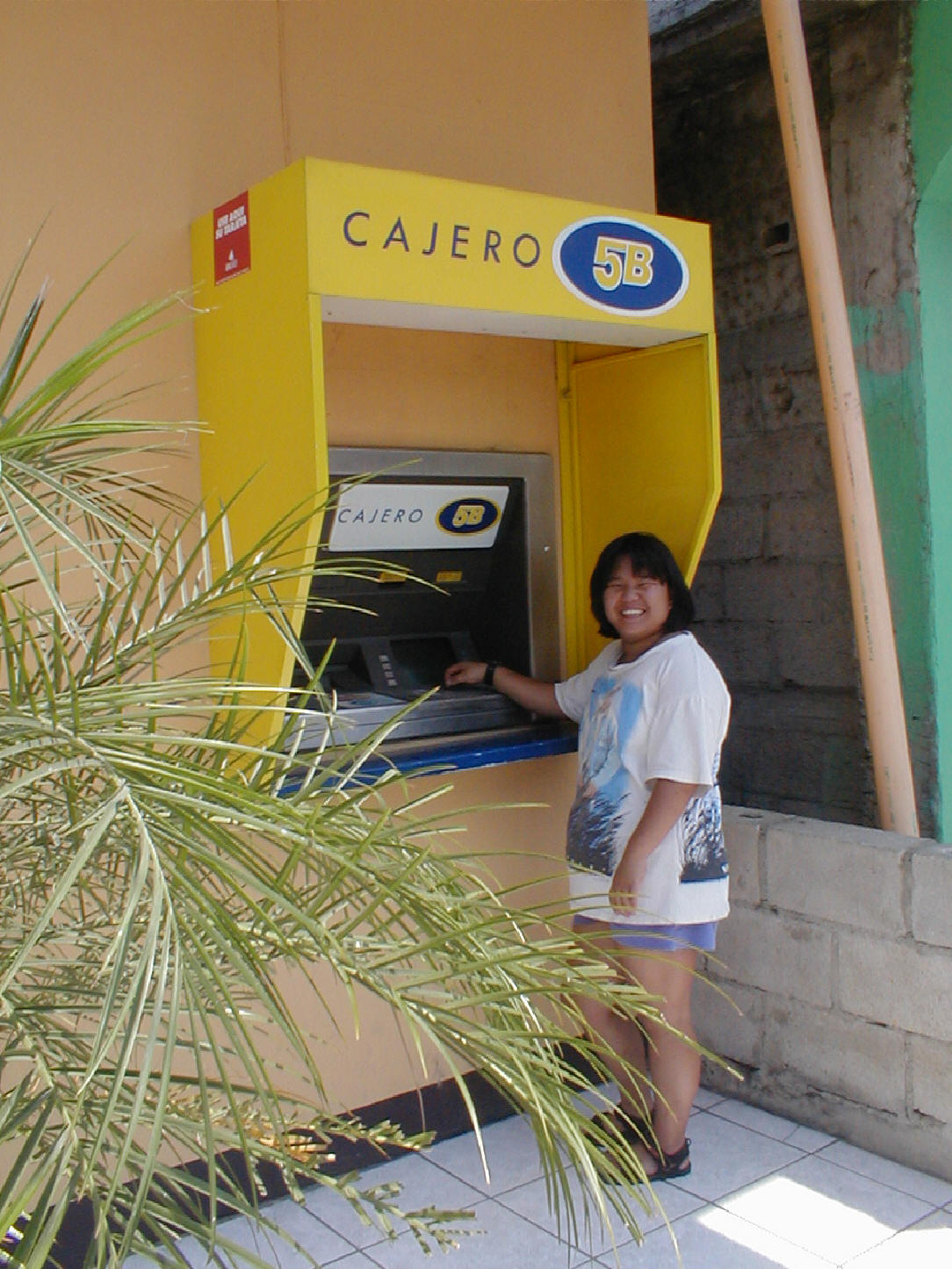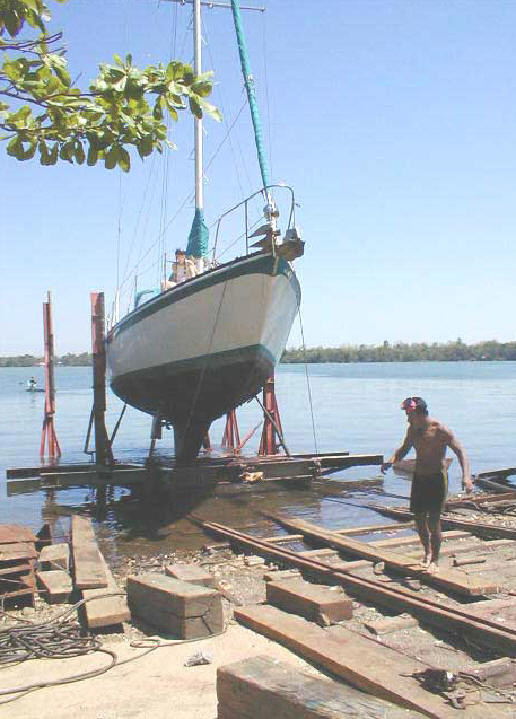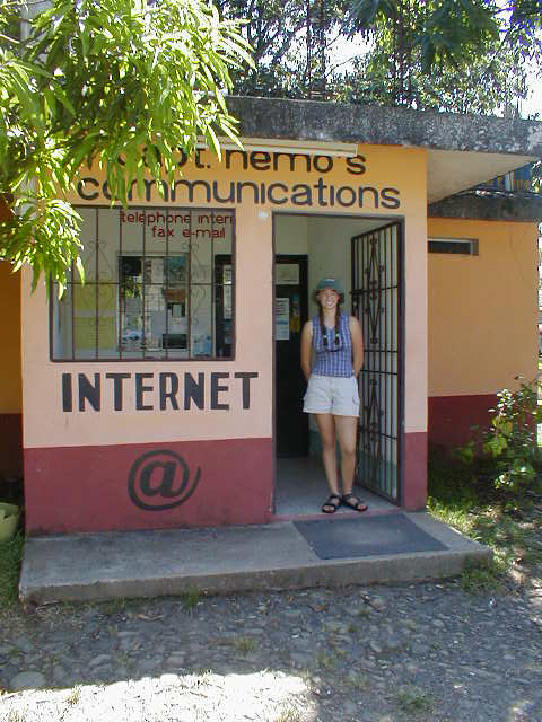The granddaddy of all cruising
questions naturally concerns money. How much does it cost to go cruising?
In the cruising community the answer is often a tongue in cheek, "it costs
whatever you have to spend."
That answer can actually be pretty close to the truth. Those with a real
desire to live the cruising lifestyle will do whatever they have to do to
make sure that their budget allows them to cruise. If their budget allows
for $800 a month, then they will make whatever sacrifices to keep within
that budget. The alternative - not cruising - simply isn't an option. For
those with champagne and caviar budgets, well, they seem to find a good
place to spend their "allowable" budget.
What do you need to include in your cruising budget? Here's a good start,
assuming that you own your boat.
Food
Cruising food budgets can vary widely. A good number to start with is with
the same amount that you spend for food while living on land. If you are a
frugal shopper on land, you will probably be a frugal shopper while
cruising. If not, you can always learn to be.
Your grocery bill can skyrocket while cruising if you don't take care of a
few simple things.

1. Provide for plenty of on board storage areas for provisioning. This
allows you to stock up where prices are cheap.
2. Stock up where prices are cheap. If in the US, avoid the convenience
stores. Often times they may be the only place within walking distance of
your anchorage or marina. If you've stocked up well, you won't need to
shop there. If in foreign countries, find out which areas are good
provisioning stops and avoid others. Shop at fresh produce markets for
good prices on local fruits and vegetables.
3. Provision with care. This means learning how to properly store food for
long-term storage. Food that must be thrown out is wasted money.
4. Remember that taxi rides to markets are an added expense. Take
advantage of opportunities where you can walk or where a courtesy car or
cheap bus system is available. Be sure to have sturdy canvas bags for
carrying your groceries.
Can you save money on food while cruising? Most people will tell you not
to count on it. But I think it is possible. Here are some ways:
1. Fishing and spear fishing can supplement your food supply. But just
don't depend on it. Instead, if you have a good catch, consider yourself
lucky and enjoy the savings in your food bill. We've cruised in areas
where we've dined on fresh fish or lobsters that we've caught ourselves,
on an almost daily basis for several weeks. But we enjoy fishing and spear
fishing. If you don't enjoy it, don't bother. Although our equipment is
fairly minimal, you do need some equipment. You may also need a license,
which is another expense. We've also cruised for months without
supplementing our diet with fish or seafood, because the season was
closed, we hadn't bought a fishing license, there was a fear of ciguatera
poisoning, or the fish just weren't biting.
2. If you were never a frugal shopper on shore, but your budget now
demands that you become one, I believe that you can lower your food bill.
Learn to eat more grains and beans and less meat. Shop for local fruits
and vegetables that are in season. Bake your own fresh bread. Avoid
convenience foods and bake from scratch. You'll find that you probably
have more time to do this when cruising and many people enjoy it.
Dining out is another area of your food budget that can easily go up or
down compared to what you spent while living on shore. If you previously
spent a lot of money on business lunches and dinners, or if you bought a
lot of take out food because of your busy lifestyle, you may find that you
spend less on dining out while cruising.
If you believe that part of the fun of cruising, is to taste the local
cuisine, you may find you need to budget more money for eating out. To
stretch your cruising budget, try eating out at lunchtime, when often the
same menu items are offered for half the dinnertime price. Stick to eating
out in countries where it doesn't hurt the budget so much. For example in
Mexico we've eaten at wonderful cafes where our family of four had a
delicious meal for around $3.00 - TOTAL.
We've been living aboard our 1974 41' sailboat, Out of Bounds, for over
ten years. Presently, we average about $500 a month for our family of four
for food and dining out. We may spend $700 one month stocking up on
long-term provisions and only spend $75 the next - mainly on fresh foods
picked up at various markets. If we are visiting an expensive country we
tend to eat out very little, if at all. But if dining out is affordable,
we may eat out once or even twice a week. Our food budget also includes
paper products like toilet paper and things like cat food.
Anchoring vs. Marinas
Everyone has to eat, so we all must have a food budget, but not everyone
feels the need for a marina budget. This is one place where the frugal
cruiser can save a lot of money. Marinas can quickly eat up a budget,
sometimes in just a couple of big chomps.
We spend most of our time at anchor. We love the peace, the beauty, and
the savings. We could never afford to cruise if we spent much time in
marinas.

Living full time at anchor takes some adjustments and some skills. Take
time to learn these valuable skills. You will need to have two or three
excellent anchors and develop the skill needed to anchor safely. You will
also need a safe dinghy. Your dinghy will be your only source of
transportation from your boat. If you're new to the liveaboard life, you
might want to start by keeping your boat at a marina and spend a couple of
days a week anchored out. Begin by anchoring out in good weather. Learn to
anchor, learn to use the dinghy, begin to discover what your energy needs
are and how you will permanently take care of providing your onboard
energy.
The cost of marinas varies from place to place. Transient slips may easily
cost $1 to $2 per foot per night in many places. However, there are also
places where a slip may cost you under ten bucks a night and this will
include electricity and hot showers. If you're on a budget, plan on
anchoring and if you come across a great marina deal and feel like
splurging for a night or two, you won't break the bank.
You can generally find a big savings if you pay for your slip for a month
or more at a time. So if you plan on staying in one spot for a while,
check out the marina's long-term rates. This is a good idea if you plan on
doing some land traveling and want to leave your boat for a bit.
Looking back at our expenses, I see for example, a six-month period where
we spent $64 total for what I considered "marinas" although we never
actually spent a night in a slip. We spent $14 for a week's use of a
dinghy dock (which included use of showers and laundry facilities) and $50
for a mooring ball in the Exuma Land and Sea Park. Anchoring is not
allowed here, so you must rent a mooring ball if you want to visit. We
spent about ten days here, weathering out a storm. We "paid" for part of
our stay by volunteering our time doing chores around the park.
Fuel
We're sailors and I hate the noise of our engine, so we tend to sail as
much as possible. I'm also cheap and hate to spend too much of our budget
on fuel. However, we do motor or motorsail almost 100% of the time on the
ICW. We usually use the engine to get in or out of passes especially if
the current is against us. We'll motor when we need good light to navigate
a pass and our sailing progress is too slow to make it in time. With four
of us living aboard and being avid snorklers and explorers, we use the
dinghy with outboard a lot. So we must consider dinghy gas as well. We
have a second dinghy, a rowing/sailing dinghy which the kids use all the
time. Free fuel!
Here's a look at a recent fuel budget for Out of Bounds:
Month 1 - $130 - we were on the ICW (fuel prices were inexpensive but we
were motoring a lot)
Month 2 - $43
Month 3 - $36 for diesel and $32 for dinghy gas (we were paying very high
prices per gallon)
Month 4 - 0 for diesel fuel (we were anchored in one spot for most of the
month) and $20 for dinghy gas
When planning your fuel budget, you will need to keep in mind:
Your own fuel mileage
The cost of fuel in various locales
The distance you are traveling
How much of your traveling is done under sail only
Entertainment
Entertainment costs might include admission fees to museums, car rental
fees for sightseeing, ice cream cones or a couple of beers now and then.
Fortunately most cruisers find that the best forms of entertainment are
free. Our favorite activity is snorkeling, which is free. Air fills for
the scuba tanks generally cost about $2-$5 each. We also enjoy hiking or
just walking around a new town. Bonfires on the beach or potlucks dinners
with other cruisers are wonderful activities that cost nothing. Other
inexpensive sources of entertainment include paperback book or videotape
exchanges. My husband, Tom, enjoys listening and talking on the SSB/Ham
radio. Although there is an initial cost for the equipment, once bought
it's a relatively free hobby. Our daughter Kate loves to stargaze, another
free activity. We're all avid readers. My favorite evening activity is
simply having a cold beer in the cockpit with Tom while watching the
sunset after a wonderful day of snorkeling
|
|

Maintenance
Learning to maintain your boat's systems yourself will save you a bundle
of money. Also the less systems you have to maintain, the less you will
have to spend (in both time and money) on maintenance. In conversations
with other cruisers it seems that water makers and refrigeration systems
seem to cause the most headaches. If you have them aboard, learn all you
can about them. Most cruisers seem to become quite good at maintaining
their diesel engines and their outboards.
Keep a good supply of spare parts aboard. Having to buy needed spare parts
when you're in the middle of paradise will not only cost you more, but you
will have to pay shipping charges and probably import duties. Being
prepared will save money in the long run.
Since Tom has become very adept at repairing most everything aboard Out of
Bounds and because we keep a good supply of spare parts aboard, our
maintenance costs are relatively low.
We haul out every couple of years to give the boat some fresh bottom paint
and for other maintenance.
Water
Once you get to the "islands" you may have to pay for water. The most
important factor here is to become conservative with your water needs.
Take short showers, don't let the water run when shaving or brushing
teeth, don't waste a drop. We carry 140 gallons in our tanks plus 24
gallons in jerry cans on deck plus a couple of gallons in our solar
shower. We don't have a water maker on board yet. We can generally go for
about 3 weeks without running out of water, although we like to try to
fill up every couple of weeks.
Gear
This can be a large expense, especially when you're first starting out. We
bought our boat and moved aboard immediately but kept working for our
first few years of liveaboard life. We upgraded the boat slowly over the
past thirteen years and took our time deciding what gear we needed and
when we needed it. We bought much of our equipment used. Other cruisers
buy boat and gear all at one time while they have paying jobs and then
take off cruising.
Your boat may come fairly well equipped when you buy her but over time,
you'll want to make upgrades or replace worn gear. Remember to budget for
charts and guidebooks as well.
Health insurance
It's a personal decision on whether or not you'll carry health insurance.
Boat insurance
We insure our boat for about $175 a month (although the premium is due in
one lump sum). This allows us to cruise the US, the Bahamas and the
Caribbean (with several restrictions). For us, it is worth the peace of
mind to carry insurance.
Boat US and West Marine have policies for boats cruising the US and
Bahamas. For cruising further, check out Bluewater Insurance at
www.bluewaterins.com

Mail
There are various mail services, which will collect and forward your mail
for a fee.
We rent a Post Office box in my hometown. My brother collects the mail for
us and then forwards it to us per our instructions. We pay about $5 a
month for the box rental (fees vary from post office to post office). Then
we pay my brother for his cost to forward the mail. We generally have him
forward the mail once every two months or so and the cost averages about
$10- $15 a month.
To save money on mail forwarding, be sure to not have junk mail and
unwanted catalogs forwarded.
Laundry
Cruising doesn't require wearing a lot of clothes, at least in the
tropical regions, but somehow the laundry seems to accumulate. We hand
wash most of our laundry using the non-electric "Wonder Clean" pressure
washing machine (cost is about $45) and then line dry. You may want to
budget about $15 - $20 a month for doing laundry in shore side facilities.
Phone
We've used a phone card and payphone for all of our phone call needs. We
have found that the prepaid calling cards sold at Sam's Club, Wal-Mart or
Costco to be a good buy. If you are cruising to foreign countries, be sure
to find out what the access code is to call from that country to the US.
Also find out what the per minute rate of the call will be. In some
countries such as the Bahamas, you may not be able to use your prepaid
calling card. To use the payphones in the Bahamas, you will have to buy a
phone card from Batelco (Bahamas Telephone Company). They are available at
most supermarkets.
We now communicate almost exclusively via email and avoid the payphones
altogether. We bought a HF modem to hook our SSB radio to our notebook
computer and we use SailMail. The cost for SailMail is $200 a year. There
are no other fees with SailMail. Check them out at:
www.sailmail.com.

Other Costs
We budget for cooking fuel (propane for us - a tank lasts us about 6 weeks
and cost anywhere from $8 to $30 to refill)
Other things you may need to budget for include:
Home schooling supplies and materials
Airfare home
Custom and immigration fees
Hair Cuts
Souvenirs
Fishing License
Prescriptions
garbage disposal
Wow, that may all seem like a lot of stuff to budget for. But there is
some good news. You won't have to budget for mortgage payment, car loan,
electric bill, phone bill, cable TV, water and sewer bill, garbage pickup,
car maintenance, gas for your car, homeowners insurance, car insurance,
parking fees, etc.
You'll also find that this lifestyle requires little in the line of a
clothing budget (shorts, T-shirts, sandals and swimsuit will probably be
your usually garb). You won't feel the need for keeping up with the
Jones'. Vacation and travel are already built in. Most people will find
they spend less on entertainment, as cruising is entertaining in itself.
All in all, most people are able to cruise for less than they can live on
land. And most people are willing to give up a few things, if necessary,
to ensure that they can afford to cruise. Some cruisers get by on as
little as $5,000 to $10,000 a year by living very frugally. There are a
lot of cruisers out there with a yearly budget of between $12,000 and
$18,000 a year, including us. If you can budget $18,000 to $25,000 a year,
you'll have it made. Got more than $25,000 a year? No problem. The bottom
line, it'll probably cost you as much as you have to spend.
Barbara Theisen has spent the past thirteen years living aboard Out of
Bounds with her husband Tom and daughters, Kate and Kenna. They are
currently cruising the Northwest Caribbean. For more information on living
the cruising life visit the Theisen's Website at www.TheCruisingLife.com.
|




